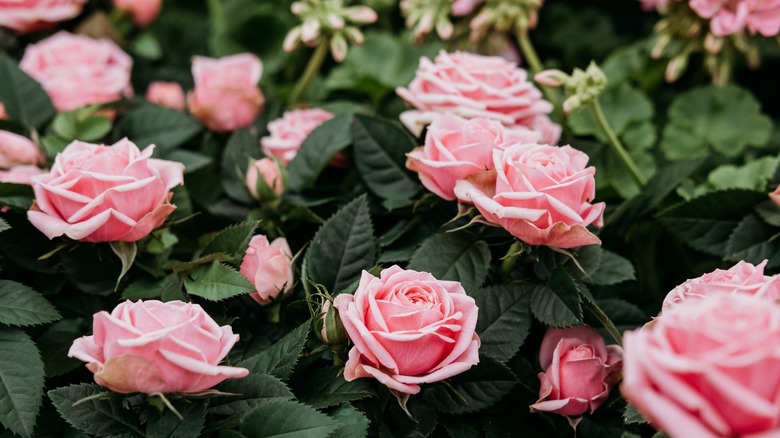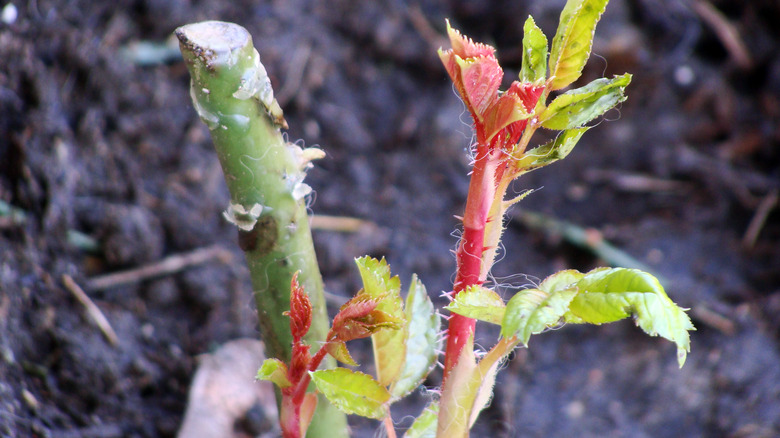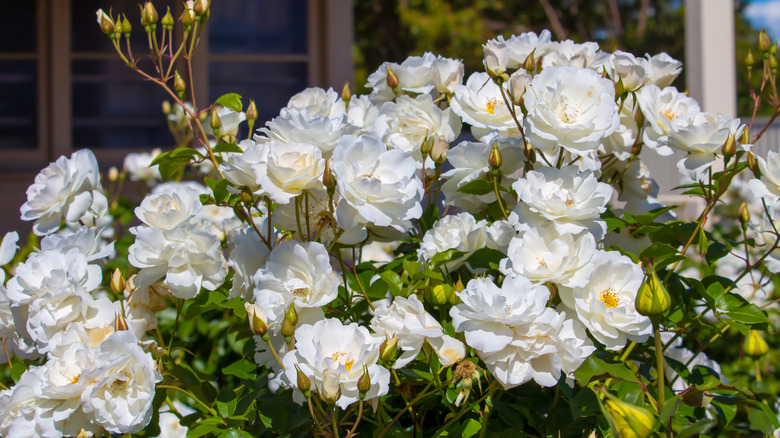What It Means If The Roses In Your Garden Are Changing Colors
The sheer difficulty of growing roses (Rosa spp.) often isn't enough to dissuade the laziest gardener from planting them, since the payoff involves gorgeous, sweet-smelling flowers. But when these otherwise distinctly-hued beauties begin changing colors, you might think — as William Blake did — "O Rose thou art sick." Surprisingly, worms or bees aren't responsible for the metamorphosis; instead, the reason is often a weather change. A slight deviation in their desired growth environment is enough to cause roses to subtly-intensify or weaken their shades. Other reasons include that your grafted rose bush is growing suckers or you're dealing with a sport, a naturally-occurring genetic mutation.
To understand why roses change color in different temperatures, here's a short chemistry lesson. The deep reds, pinks, and purples you associate roses with are a product of anthocyanins. These pigments aren't very stable and vary significantly in response to environmental changes. So, even though roses enjoy basking in the sun if the heat exceeds their tolerance levels, their anthocyanin levels will drop, causing the blooms to wash out. Conversely, cooler temperatures can deepen the pink and red shades. The 'Blushing' variety, which initially shows up as a pretty pink in spring but later fades into a delicate white in the summer, is a peak example. Genetics are key, too, since they define the intensity of change. For instance, phototropic rose varieties, like Double Delight and Color Magic, are more reactive to heat and light variations.
Grafted roses show their true colors
Sometimes, the color changes are dramatic. For example, a white rose bush may directly develop crimson-red flowers instead of pink pastels, as is the norm for weather fluxes. Such transformations can be attributed to sucker stems growing from grafted bushes wherein one plant's scion (upper segment) is budded on another, more robust species' rootstock. To tell if a plant is grafted, check for a bloated knot on the trunk near the ground level.
Rose cultivars are often embedded on 'Dr. Huey', a variety renowned for its burgundy-red flowers. 'Multiflora' and 'Fortuniana' are other alternatives. Generally, grafting is a non-issue since the rose shrub displays flowers from the preferred variety while benefiting from better endurance and longevity. But if the scion dies or the rootstock outcompetes it, your roses may noticeably transmute. Although every rose has its thorns, they appear similar throughout the bush. So, if you notice major differences in the plant from foliage and stems to blossoms, know the rootstock has been shooting up its stems and expressing its genes. This problem often crops up when the rose shrubs are planted shallowly. To save your chosen flower variety, prune the rogue sucker at its origin.
Roses produce sport or phyllody blooms
Like every creature on this planet, roses continue to evolve, which occasionally shows up as variations in flower colors. Unlike a sucker stem from a grafted bush which showcases a different set of leaves and flowers, a sport resembles the original plant in almost everything, including the flowers shape and smell – except the hue. This indicates the rose bush has mutated, and you can propagate it to create a new variety. 'Blushing' came out of 'Knock Out' when its odd branch was bred. Similarly, 'Iceberg' has birthed several sports, including 'Climbing Icebergs' and 'Burgundy Icebergs.' However, not all such mutations are permanent, and roses can regress to their previous forms after fixing their DNA. Unfortunately, you can't thwart its reversal.
Rarely, you may notice that instead of a color variation, the rose has developed leafy growth in its center, like 'The Green Rose'. Such modified flowers are called phyllody blooms, and floribundas are their greatest producers, given their genetic build-up. They're usually a consequence of hormones going whack from drought stress, excessive heat, or an unwanted visit from leafhoppers. Luckily, the flowers usually revert to their original appearance after the conditions become conducive.


